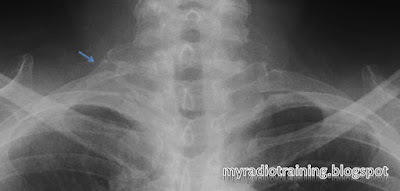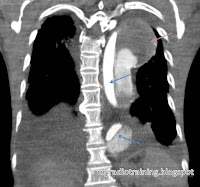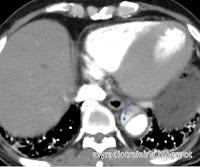Psoriatic arthritis
Polyarticular arthritis
Skin disease: Psoriasis (Skin rash)
Chronic inflammatory
40yo, Caucasian
?Factors involved: Genetic, Immune system, Environmental
HLA-B27 +ve in 60%
Hand:
- Most commonly involved skeleton
- Interphalangeal joint (PIJ, DIJ)
- 'Fluffy periostitis'
- Bony proliferation*
- Joint erosion from articular margin* to centrally.
- Tapering of one end, saucerisation of the other end of the articular surface: Pencil-in-cup deformity
- Preserved bony mineralisation (no osteopenia), ivory phalanx
- Ankylosis
- Diffuse soft tissue swelling: Sausage digit
SIJs:
- Asymmetric sacroiliitis, sclerosis, large erosion
- Ankylosis is UNcommon
Vertebra:
- More commonly involved in MALE
- Asymmetric
- Atlanto-axial subluxation
- Squarring of vertebrae
- Enthesitis: comma-shaped ossification, paravertebral (parasyndesmophytes)
- Thoracolumbar region
Others:
- MTPJ
- TA insertion of the Calcaneum: Fluffy periostitis & Erosion
*HALLMARKS for Psoriatic arthritis
DDx:
- Ankylosing spondylitis (Ossification less bulky, symmetric sacroiliitis)
- Reactive arthritis (Genitourinary symptoms)
- Hyperparathyroidism (similarity: presence of large SIJ erosion)
Polyarticular arthritis
Skin disease: Psoriasis (Skin rash)
Chronic inflammatory
40yo, Caucasian
?Factors involved: Genetic, Immune system, Environmental
HLA-B27 +ve in 60%
Hand:
- Most commonly involved skeleton
- Interphalangeal joint (PIJ, DIJ)
- 'Fluffy periostitis'
- Bony proliferation*
- Joint erosion from articular margin* to centrally.
- Tapering of one end, saucerisation of the other end of the articular surface: Pencil-in-cup deformity
- Preserved bony mineralisation (no osteopenia), ivory phalanx
- Ankylosis
- Diffuse soft tissue swelling: Sausage digit
SIJs:
- Asymmetric sacroiliitis, sclerosis, large erosion
- Ankylosis is UNcommon
Vertebra:
- More commonly involved in MALE
- Asymmetric
- Atlanto-axial subluxation
- Squarring of vertebrae
- Enthesitis: comma-shaped ossification, paravertebral (parasyndesmophytes)
- Thoracolumbar region
Others:
- MTPJ
- TA insertion of the Calcaneum: Fluffy periostitis & Erosion
*HALLMARKS for Psoriatic arthritis
DDx:
- Ankylosing spondylitis (Ossification less bulky, symmetric sacroiliitis)
- Reactive arthritis (Genitourinary symptoms)
- Hyperparathyroidism (similarity: presence of large SIJ erosion)


























